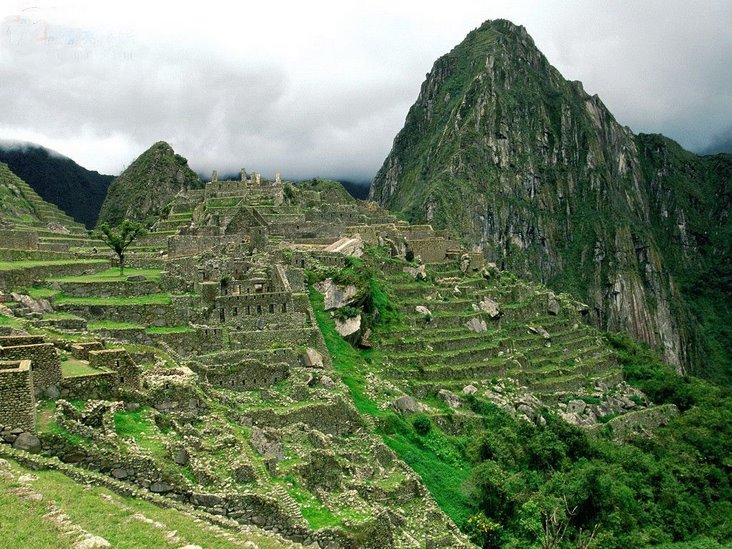The beginnings of the Inca Empire
印加古國的起源
are mysterious as well.
也很神秘
It seems their rise to power began around 1200AD
據說他們開始建立是在1200年
as they gradually acquired power
他們的影響力
over neighboring peoples.
逐漸波及到周圍的民族
At this point the Inca Empire extended
當時印加古國的領土
for roughly 2500 miles
沿南美的西海岸
along the western coast of South America
差不多有2500英里長
encompassing much of modern Peru and Chile
包含了現在秘魯和智利的大部
with parts of Ecuador.
以及厄瓜多爾的一部分

Its population at that time
當時的人口數
is estimated to be about a million people.
估計有100萬
The Incans were usually satisfied to rule
印加人習慣通過
by proxy and gradual assimilation.
扶植代理人和逐步同化進行統治
That is to say they allowed local rulers
也就是說他們允許當地的統治者
to retain control over their peoples
保留一定的權力
as long as these local rulers paid their taxes,
只要他們按時上供
sent soldiers and obeyed the Incans.
派出戰士,服從印加人的統治
The city of Cuzco in the Peruvian Highlands
秘魯高地上的庫斯科
was the center of a large bureaucratic government
曾是當時龐大管理機構的中心
connected by an excellent road system.
交通也四通八達
At the center of the government was the Inca;
當時的統治中心是印加國王
son of the almighty Sun God
全能的太陽神之子
and supreme master of all of his subjects.
臣民的最高統治者
You could say he had some serious imperium.
可以說他有一定的統治權
In 1521 the Spanish conquistador
1521年西班牙的征服者
Francisco Pesaro set out
弗朗西斯科佩薩羅
with a mere 200 soldiers to conquer the Incans.
和一支只有200人的隊伍出發征服印加
200 well armed soldiers.
200名全副武裝的戰士
Pesaro emulated Cortez's sleazy tactics
佩薩羅模仿了科爾特斯卑劣的手段
without enjoying Cortez's success.
卻沒有獲得科爾斯特一樣的成功
Pesaro started by kidnapping the Inca,
佩薩羅一開始綁架了印加國王
Atahualpa whom he tried to use as a puppet ruler.
阿塔瓦爾帕,作為自己的傀儡統治者
Finally Pesaro executed Atahualpa in 1533.
最后佩薩羅在1533年處死了阿塔瓦爾帕
By the 1560's, after a long and difficult fight,
在十六世紀60年代,經過漫長和艱苦的戰斗
the Incan Empire had fallen to the Spaniards
印加古國落入了西班牙之手
and adding to the territory taken from the Aztecs.
和阿茲特克的領土連在一起
Having wiped out a 2nd great American Empire
在摧毀掉第二個最偉大的美洲古國后
the Spaniards were again busily exploiting their new,
西班牙人又再一次開始了自己的擴張
improved Terra Nullius.
占領新的無人之地
The Indians of North America;
北美印第安人
the earliest known Indian culture
美國東部最早知道的
in the eastern United States is
印第安文化是
that of the Adana
阿達那文化
which appeared in the Ohio River valley
它大約于1000bc
around 1000BC.
出現于俄亥俄河谷
The Adana began building burial sites
阿達那人在600BC開始建立
and fortifications around 600BC.
自己的葬址和防御工事
The Adana culture was replaced or absorbed
之后阿達那文化被
by the more advanced Hopewell culture
更先進的霍普韋爾文化所取代或吸收
who built more prolifically
霍普韋爾人建立了更多的建筑
and seems to have traded extensively.
而且似乎也進行了廣泛的貿易
Around 500BC
在500bc左右
the Hopewell culture gave way to
霍普韋爾文化讓位于
the Mississippian or Temple Mound culture
密西西比土墩群文化
best represented today
我們今天能看到的
by the ruins surviving at Cahokia, Illinois,
最好的遺址就在伊利諾伊的卡俄基亞
a city right across the Mississippi River
就在圣路易斯密西西比河的
from St Louis.
對面
In fact the term Cahokian
事實上,人們有時候也用
has sometimes been used to denote this culture.
卡俄基亞來指代整個文化
By the 1100's as the Byzantines
1100年時,當時的拜占庭人
were fighting off the Crusaders,
在抗擊十字軍
Cahokia may have had
卡俄基亞人已經有
as many as 20000 people living a town
2萬人居住在
centered around a huge earth mound
以土丘為中心的鎮上
which exists to this day.
這到現在還存在
Like the Hopewell culture
和霍普韋爾文化很類似
the Mississippian culture relied on hunting,
密西西比文化以打獵
agriculture and trading.
農業和貿易為主
The Mississippians may even have held slaves.
密西西比人可能還擁有奴隸
For some unknown reason
出于一些未知的原因
Cahokia is thought to have been abandoned by 1400BC
卡俄基亞在1400bc的時候被遺棄
but its remains are a mere 3 and a half hour drive
不過它距離密蘇里州立大學的校園
from the Missouri State University campus.
只有三個半小時的車程
Well worth seeing.
很值得一看











